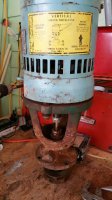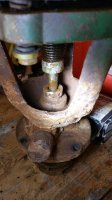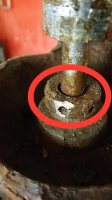Thrown into trying to fix this leak at my house. Never heard of Head FT, GPM, etc. The leaking is occouring where the impeller rod is (see file). I've now learned there is a motor, and pump housing. After many emails with Thrush (very kind CS rep working me) they were finally able to give me a solution. Sort of. they gave The model number of this bracket is HV-600N, and part number 1504-900. Said the pump is obsolete but not the bracket. Of course googling these seem to come up with something that looks a bit different from what I have (see pics). And looks like a bell & gosset housing. How can i tell if a replacement would fit my motor
The only other option I have is to buy a complete new set. But, then this requires the matching of Head ft, figuring the gpm etc. And of course hiring someone. But, I'm just thinking I could replace the pump area, the motor works great.
On the pics, the red circle is where it currently leaks. I tried to remove the impeller from this, but top of spring removes from motor rod but can't seem to remove the impeller rod from spring..
Sorry for being such a newbie here and asking such a question, I'm just trying to get "heat" in the old house without spending thousands..
The only other option I have is to buy a complete new set. But, then this requires the matching of Head ft, figuring the gpm etc. And of course hiring someone. But, I'm just thinking I could replace the pump area, the motor works great.
On the pics, the red circle is where it currently leaks. I tried to remove the impeller from this, but top of spring removes from motor rod but can't seem to remove the impeller rod from spring..
Sorry for being such a newbie here and asking such a question, I'm just trying to get "heat" in the old house without spending thousands..



